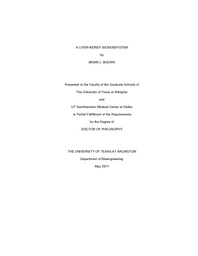| dc.description.abstract | Each year many patients die waiting for a transplant organ to become available. Increasing the available number of transplant organs would save lives. The donor pool could be expanded if organs which are considered to be of uncertain viability could be utilized for transplantation. Currently, when there is any doubt about the viability of the organ, it is discarded. This occurs because there has been no way to confirm its viability other than to transplant it and risk the life of the recipient. Thus, many organs that are in fact good are wasted. Some might not be fully viable but could be improved ex vivo if there were a platform to do so. One of the most important organs for transplantation is the liver due to its essential role in intermediary metabolism, and the lack of an acceptable artificial substitute.
For decades, "static cold storage" has been used to cool transplant organs to near freezing and transport them in an ice cooler to the site of transplantation. Studies have shown that livers removed from donors after blood flow has ceased (such as accident victims who no longer have a heartbeat) are less likely to be usable if exposed to static cold storage, but livers taken from cadavers even more than an hour after cardiac death are still found to be viable for successful transplantation if warm-perfused on a device similar to a heart-lung machine, known as a "normothermic perfusion device". Normothermic perfusion devices currently in clinical trials typically pump warmed, oxygenated blood through an organ, and are often portable so they may be used to transport the organ in a living, functional state, thus avoiding the cold storage which is detrimental to such livers. Further, since the organ is in a functional state during transportation, its function can be monitored and tested while en route. Use of normothermic perfusion devices should greatly expand the number of donor organs available since organs from accident victims as well as any other questionable organs may now be functionally tested. In the case of liver transplantation, recent studies have shown that normothermic perfusion devices also double the preservation time from about 12 hours using static cold storage to at least 24 hours using normothermic perfusion, allowing the liver to be transported longer distances or to wait longer for recipients to prepare for surgery.
As good as they are, the normothermic perfusion devices currently in clinical trials cannot indefinitely preserve a transplant organ. In this dissertation, a theoretical upper time limit for liver preservation in one of these normothermic perfusion devices is projected to be about 4 days. This is primarily due to the fact that the waste products of metabolism build up in the blood; they are not removed as they would be within the body because other organs which would remove these toxins are not present.
In this dissertation, a collection of cross-supporting organs which meet all essential requirements for long-term (weeks or longer) functional preservation outside the body is proposed. This system of organs forms a long-term self-sustaining subsystem ex vivo. It is a subsystem since the full body (as a system) is not present. A subsystem comprised of cross-supporting organs which meets a set of criteria for long-term functional survival outside the body is defined here as a biosubsystem. A biosubsystem which uses a liver and a kidney cross-supporting each other is called a liver-kidney biosubsystem.
In five successively improved designs, a liver-kidney biosubsystem was implemented and tested for durability using pig organs. It achieved about 2 days of functional normothermic preservation of the liver, but (so far) has not achieved a goal of 6 days or longer.
It is believed that this is the first ever attempt to collect multiple organs from the same donor with the intention of having them cross-support each other during normothermic perfusion in order to greatly extend the time of functional preservation.
In support of this research, the appendices contain derivation and correct usage of the equation for calculation of percent hemolysis in blood, explanation for the factor of 3 relationship between hemoglobin concentration and hematocrit (and when the relationship breaks down), derivation and comparison of resistance units used in calculating vascular resistance, and an in-depth review of historical data on the absorption spectra of hemoglobin. A new wide-ranging composite set of spectral absorption coefficients (also called absorptivities or extinction coefficients) are extracted from those works for oxyhemoglobin, deoxyhemoglobin, methemoglobin, and carboxyhemoglobin, and made publicly available in an accompanying spreadsheet file. | |


